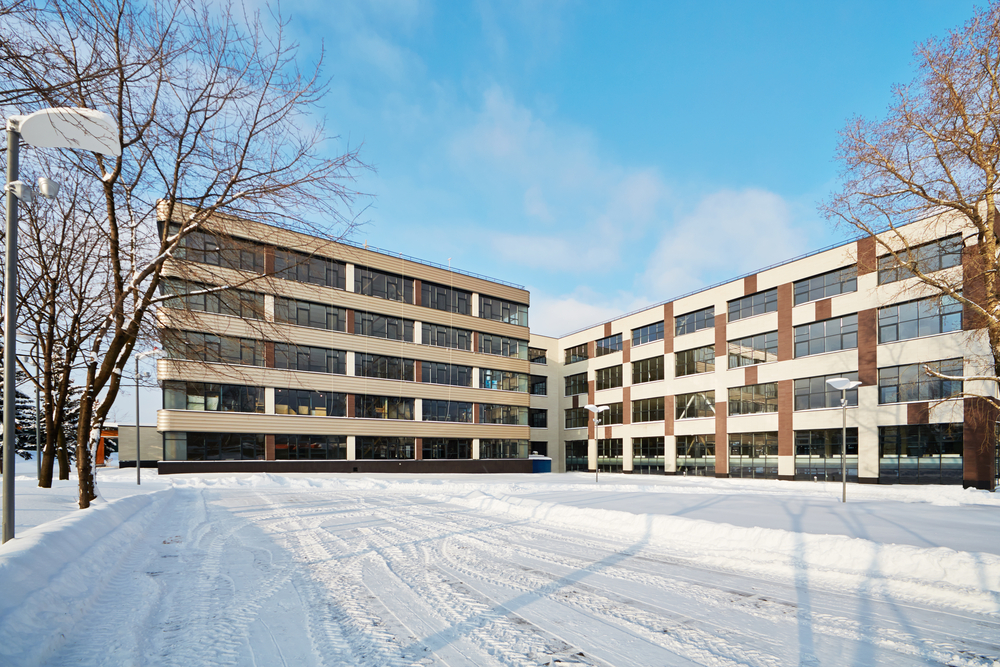With winter on its way, it’s time for facilities managers not only to prepare for snow and ice and winterize their irrigation systems, but also to examine the interior and exterior elements of their facilities. Whether you manage a large facility like a college or hospital campus or a small facility like a small office building, there are important steps you should take to prepare for this coming season.

Failing to be prepared can be costly, according to DisasterSafety.org, which states that severe winter weather is a “significant cause of insured catastrophic losses and is a risk for many businesses across the country, including portions of the typically warmer southern United States.”
1. Snow and Ice Removal
For many of us, winter brings snow and ice, which means taking care of snow and ice removal to ensure the safety of customers and employees.
Facilities managers should therefore decide whether to use their own staff or choose a provider. Learn more by reading “Getting Your Facility Ready for Snow and Ice” on Facilities Management Advisor.
Facilities professionals who remove snow and ice should take the following into consideration:
- Roads: Facilities with internal roads, like large hospitals and college campuses, should use traditional snowplows and gritters, which spread rock salt. Use liquid brine, a pretreatment with rock salt and water, up to three days before a winter weather event. Roads should remain passable for emergency vehicles.
- Parking lots: Snowblowers or shovels should be used in small parking lots, while snowplows or loaders, along with rock salt, should be used for large parking lots. Everyone should also ensure handicapped parking spaces and curb cuts are clear.
- Sidewalks: Use shovels to remove snow from sidewalks and steps. The Occupational Safety and Health Administration (OSHA) advises using shovels to scoop small amounts and push the snow rather than lift it. For large facilities with lots of sidewalks, consider walk-behind loaders and snow throwers.
- Building entrances: Shovels and a non-chloride potassium formula should be used near main doors. Avoid using calcium chloride and magnesium chloride, which can be tracked inside facilities and cause indoor falls, especially on tile surfaces. Install floor mats, and ensure pathways to and from emergency exit doors are cleared.
2. Winterize Irrigation Systems
Water expands when it freezes, which can cause various fixtures to break and do damage to irrigation systems.
Ensure these components are winterized:
- Safeguard sprinklers: Use an air compressor to blow out water, shut off the water supply, drain the pump, remove it from the system (if possible), and bring it indoors. If the pump can’t be removed, wrap it with insulation.
- Shut off outdoor faucets: Shut off water valves, and drain facet fixtures. Disconnect hoses, use an outdoor faucet cover, and consider installing a frost-free faucet.
- Protect outdoor pipes: Insulate pipes using a “pipe sleeve,” or install UL-listed “heat tape,” a “heat cable,” or similar materials.
- Swimming pools: Hotels, fitness clubs, and municipalities that have outdoor swimming pools should drain the water out and follow the manufacturer’s instructions. Antifreeze shouldn’t be used, as it could be damaging to the environment.
3. Interior Inspection
There are several important elements that should be inspected before Jack Frost arrives:
- Heating, ventilation, and air conditioning (HVAC): Perform preventive maintenance to ensure the system is operating safely and efficiently. Change the air filters, and check that exhaust gases are being ventilated properly. Before an unexpected outage or maintenance issue arises during the winter season, select a heating system repair service, and negotiate an emergency rate in advance. Losing heat in your facility, even for a few hours, could affect the bottom line.
- Insulation: Check your building’s insulation for holes that could cause heat loss. Determine whether the building’s insulation is sufficient or whether it’s necessary to add or update it. Considering different types will save on heating costs.
- Thermostat/humidity controls: Ensure your facility’s thermostat and humidity controllers are working properly, and think about the unique needs of your facility. Consider replacing old thermostats with new ones that can reduce carbon dioxide (CO2) emissions and costs.
4. Exterior Inspection
Before the temperatures consistently go below freezing, take a walk around your facility to check several important components:
- Windows and doors: Ensure seals around windows and doors aren’t compromised. Get a building pressurization test and a thermographic inspection to determine if there’s any air leakage that could substantially increase heating costs over the winter season.
- Walls and foundation: Check to see if there are any spots where snow could collect and melt into the building interior. Failing to do this could result in costly mildew and mold damage that could be harmful to occupants. It’s cheaper to pay for foundation and wall repairs now than replace them later.
- Roof: Perform a roof inspection by checking for damage that could worsen once the snow starts flying. Check for standing water, animal damage, and debris. Clean the roof using a leaf blower or a soft-bristled broom, as power washing could cause damage. Determine the “snow load,” or the weight of snow, that the roof can handle before it fails. For more money-saving tips, visit “10 Ways to Keep Heat and Money from Going Out the Window” on Facilities Management Advisor.
- Trees and bushes: Trim trees to prevent them from damaging your roof during a winter storm. If there are any trees within falling distance of overhead power lines leading to the property, for safety’s and compliance’s sake, consult with OSHA and your local electric utility company to help prevent a costly business interruption.
Facilities managers should ensure their properties are ready for winter by adequately preparing for snow and ice, winterizing irrigation systems, and reviewing interior and exterior components of their facilities. While some facilities professionals might be tempted to wait until the first snowstorm comes barreling toward them, procrastinating will only make things more stressful for everyone.
